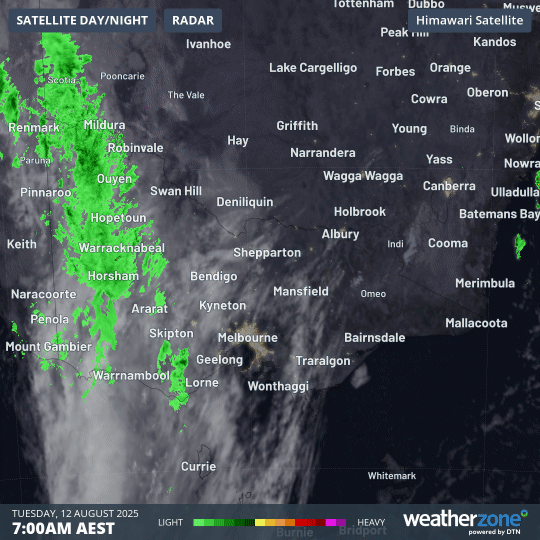Rainband stretches the entire length of Victoria
A rainband associated with a cold front stretches the full length of Victoria from north to south as it crosses the state this Tuesday, bringing welcome moisture to areas that rely heavily on winter rainfall.
Winter is the wettest time of year in most parts of Victoria, Australia’s southernmost mainland state, and it has delivered so far in most forecast districts.

Image: Two-hour combined radar and satellite loop showing the rainband crossing Victoria on Tuesday, August 12, 2025.
Victorian towns and cities (and the forecast districts in which they’re located) that saw ABOVE-AVERAGE rainfall in the first two months of winter 2025 include:
- Hamilton (South West) 148.2mm. The combined average for June and July is 138.7mm.
- Echuca (Northern Country) 110.5mm. The combined average for June and July is 83.6mm.
- Ballarat (Central) 150.6mm. The combined average for June and July is 128.8mm.
- Orbost (East Gippsland) 146mm. The combined average for June and July is 144.8mm.
- Falls Creek (North East) 273mm. The combined average for June and July is 247.5mm
The list above features towns and cities spread across different parts of Victoria, illustrating that the first two months of winter 2025 generally were healthy for rainfall in most areas.
While Melbourne’s total of 93.6mm was statistically less than average for June and July, it was only 1.9mm below average.
But August has been very dry across Victoria so far. While we’re only 12 days into the month, every drop will count in systems like today’s rainband as we near the end of winter.
Remember that many Victorian towns (especially in the state’s west) have endured longstanding rainfall deficits that stretch back to the start of 2025 and in some cases much earlier. So even if they’re on par for winter rainfall to date, more rain is welcome.
For example, the Mallee city of Mildura was very close to its combined rainfall average in June and July. But for the year as a whole, it had seen just a paltry 74.9mm of rainfall (before it received 2.4mm to 9am this Tuesday). That’s less than half its running annual average.
Meanwhile showers are continuing into mid-morning in Mildura which would be good news for most locals, while Melbourne can also expect a few millimetres later this Tuesday after a relatively dry start to August.